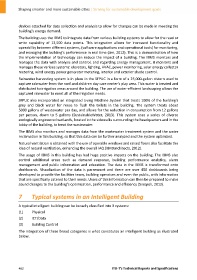Page 492 - Shaping smarter and more sustainable cities - Striving for sustainable development goals
P. 492
devices attached for data collection and analysis to allow for changes can be made in meeting the
building's energy demand.
The building uses the IBMS to integrate data from various building systems to allow for the read or
write capability of 13,500 data points. This integration allows for increased functionality and
operability between different systems, (software applications and operational tools) for monitoring,
and managing the building's performance in real time (Jim, 2012). This is a demonstration of how
the implementation of technology can reduce the impact of a building. The IBMS monitors and
manages the data with analysis and control, and regarding energy management, it monitors and
manages these various systems: elevators, lighting, HVAC, power monitoring, solar energy collector
metering, wind energy power generator metering, interior and exterior shade control.
Rainwater harvesting system is in place in the SFPUC in a form of a 25,000‐gallon cistern used to
capture rainwater from the roof and children day care center's play area. This water is treated and
distributed to irrigation areas around the building. The use of water‐efficient landscaping allows the
captured rainwater to meet all of the irrigation needs.
SFPUC also incorporated an integrated Living Machine System that treats 100% of the building's
grey and black water for reuse to flush the toilets in the building. The system treats about
5000 gallons of wastewater per day, and allows for the reduction in consumption from 12 gallons
per person, down to 5 gallons (SustainableWater, 2013). This system uses a series of diverse
ecologically engineered wetlands, located in the sidewalks surrounding the headquarters and in the
lobby of the building, to treat the wastewater.
The IBMS also monitors and manages data from the wastewater treatment system and the water
reclamation in this building, so that this data can be further analyzed and the system optimized.
Natural ventilation is obtained with the use of operable windows and raised floors also facilitate the
idea of natural ventilation, enhancing the overall IAQ (KMDarchitects, 2012).
The usage of IBMS in this building has had huge positive impacts on the building. The IBMS also
control additional areas such as demand response, building performance analytics, alarm
management and public information and education. The data in the IBMS is transformed onto
dashboards. Visualization of the data is paramount and there are over 450 dashboards being
developed to provide the facilities team, building operators and even the public, with information
that are specifically catered to their needs. Users of this information can then be prepared to make
sound changes to the building's optimization, performance and efficiency (Sinopoli, 2012).
7 Typical systems in an Intelligent Building
A typical intelligent building can be broadly classified into 3 systems:
(1) Physical
(2) ICT/Data
(3) Building Control
The integration of these broad categories is what constitutes an intelligent building as illustrated
below.
482 ITU‐T's Technical Reports and Specifications

